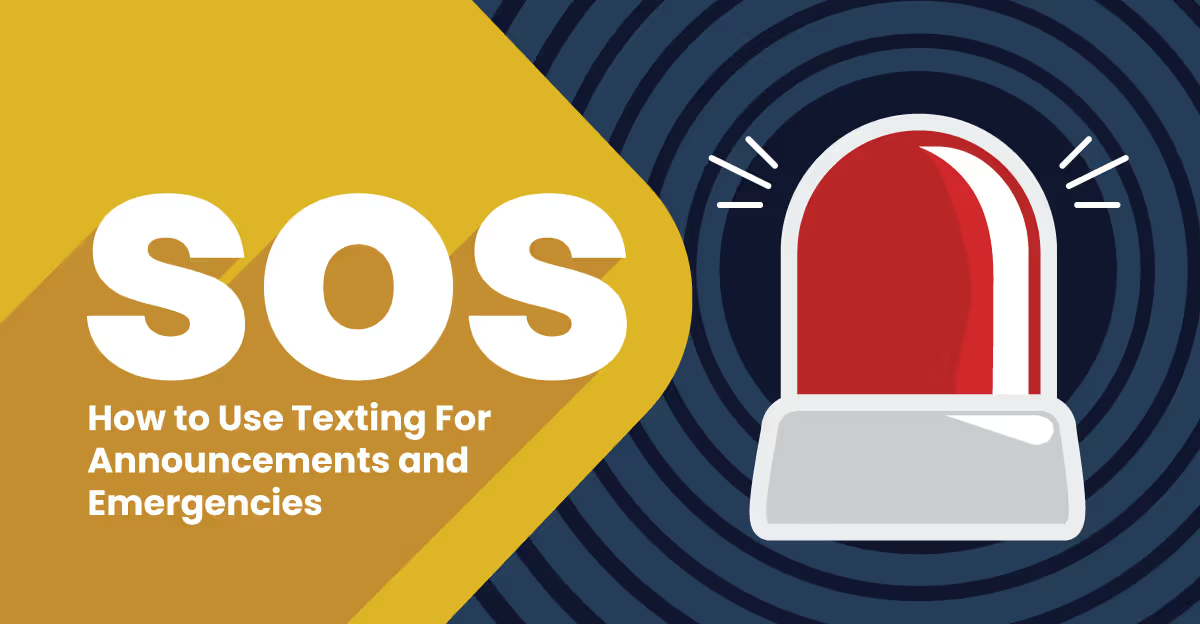How to Use Texting for Announcements and Emergencies
Learn how to send effective emergency text messages with real examples. Communicate quickly and clearly in any crisis using SMS.
Published
November 4, 2022

In high-stakes situations, the way you communicate matters just as much as what you say. Whether you're managing internal alerts, operational disruptions, or public safety messages, TextUs makes it easy to send emergency text messages that are fast, clear, and trusted.With read rates over 95%, SMS is the fastest way to get critical information into the hands of the people who need it—when every second counts.
Why Text Messaging Is Effective During Emergencies
An SMS warning system outperforms email, voicemail, and even push notifications in urgent scenarios. Unlike other channels, SMS isn’t tied to data plans or mobile apps—messages are delivered directly to a recipient’s phone via a cellular signal, even if the internet is down.Emergency SMS is especially useful in:
- Power or service outages
- Evacuation notices or building lockdowns
- System failures or health alerts
- Last-minute schedule changes
Because it’s simple, direct, and doesn’t require logging into a platform or app, texting is ideal for high-stress moments. Text message alerts reduce noise, improve reaction time, and allow you to lead with clarity.TextUs gives you a mass text alert system with real-time speed, two-way communication, and mobile-first design—built for companies that need reliable emergency communication.
When Should You Use Emergency Text Messaging?
From weather emergencies to safety drills, there are countless situations where texting is the most reliable way to alert teams, customers, or partners. You can use emergency response text messaging to communicate:
- Severe weather warnings (e.g., snowstorms, hurricanes)
- Natural disasters or wildfires
- Building lockdowns or active threats
- Public health crises or disease outbreaks
- Emergency closures or remote work shifts
- Shift cancellations or transportation issues
With TextUs, you can customize emergency SMS alerts by department, role, or location. This flexibility allows you to send targeted messages—internally to employees, or externally to customers and partners—without overwhelming your entire contact base.Your team can even schedule automated alerts for pre-planned drills or known seasonal disruptions.
Emergency Text Message Examples
Effective emergency messages are short, calm, and fact-based. Use actionable language and offer a clear next step. Here are some emergency text message examples that showcase the versatility of a business texting platform like TextUs:
- Zach, due to the state-wide snow emergency, we are canceling all classes and activities today.
- Hi Bailey! School is closed today because of the weather. Please reply “SNOW” to confirm.
- Mrs. Thomas: Ridgewood Elementary has experienced flooding. Dismissal will be at 11am.
- Hank: We are on lockdown per the front desk. Stay in your office and lock the door. More info to follow via text.
- Charlie: Following CDC guidance, the store is closed effective immediately. We’ll notify you when we reopen. (insert link to CDC)
- Shawn: Returning to the office Jan 10. Full protocol memo attached. Text back with questions! (insert PDF)
Emergency text alerts should include clear instructions and relevant links or PDFs for more information, like evacuation maps or company policies.
Best Practices for Emergency SMS Communication
A strong wireless emergency alert system includes more than just messages—it starts with preparation. Here’s how to structure your SMS communication plan for success:
- Define a chain of command. Know who can send messages and who approves them. Train those individuals in advance.
- Segment your lists. Create groups by department, shift, or role so your messages are targeted and relevant.
- Use clear templates. Pre-drafted crisis communication templates save time and reduce stress.
- Keep it under 150 characters. Emergency text messages should be short, direct, and easy to skim.
TextUs allows you to store templates, automate outreach, and manage multi-location messaging in one simple interface—so your team is ready before a crisis ever hits.
Staying Calm and Clear During a Crisis
In emergencies, your tone sets the tone. It’s essential to stay calm, confident, and factual. Avoid speculation, slang, or emotional language that could heighten anxiety.Share only verified information. Use credible sources—such as the CDC, National Weather Service, or FEMA—and include links if additional context is necessary. Your goal is to inform and reassure, not overwhelm or confuse.Great emergency SMS alerts establish trust and empower recipients to take the right action.
Follow-Up and Recovery Messaging
Communication doesn’t stop when the sirens go quiet. Use emergency SMS to provide recovery updates and next steps after the crisis passes:
- Confirm the emergency is over
- Share reopening or return-to-work plans
- Reinforce safety procedures or changes
- Provide internal resources (HR, counseling, IT helpdesk)
- Offer support or recognition for how your team handled the crisis
Try TextUs for Your Emergency Communication Needs
TextUs is more than just a texting tool—it’s a business communication platform built for real-time, human connection. Our emergency mass text messaging features help you:
- Send mass texts instantly
- Automate emergency SMS alerts
- Organize messages by group, role, or location
- Maintain two-way communication during and after a crisis
Whether you’re a healthcare provider updating frontline staff, a retailer coordinating shift schedules, or a university tackling emergency management, TextUs helps you stay ahead of crises.Get started today. Book a free demo and see how TextUs can streamline your emergency notification system and internal communication.Get a Demo
Continue Reading
Frequently Asked Questions
Business Texting
Built for Results
Create and convert pipeline at scale through industry leading SMS software




